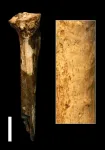(Press-News.org) People can be prone to believe in conspiracy theories due to a combination of personality traits and motivations, including relying strongly on their intuition, feeling a sense of antagonism and superiority toward others, and perceiving threats in their environment, according to research published by the American Psychological Association.
The results of the study paint a nuanced picture of what drives conspiracy theorists, according to lead author Shauna Bowes, a doctoral student in clinical psychology at Emory University.
“Conspiracy theorists are not all likely to be simple-minded, mentally unwell folks – a portrait which is routinely painted in popular culture,” said Bowes. “Instead, many turn to conspiracy theories to fulfill deprived motivational needs and make sense of distress and impairment.”
The research was published online in the journal Psychological Bulletin.
Previous research on what drives conspiracy theorists had mostly looked separately at personality and motivation, according to Bowes. The current study aimed to examine these factors together to arrive at a more unified account of why people believe in conspiracy theories.
To do so, the researchers analyzed data from 170 studies involving over 158,000 participants, mainly from the United States, the United Kingdom and Poland. They focused on studies that measured participants’ motivations or personality traits associated with conspiratorial thinking.
The researchers found that overall, people were motivated to believe in conspiracy theories by a need to understand and feel safe in their environment and a need to feel like the community they identify with is superior to others.
Even though many conspiracy theories seem to provide clarity or a supposed secret truth about confusing events, a need for closure or a sense of control were not the strongest motivators to endorse conspiracy theories. Instead, the researchers found some evidence that people were more likely to believe specific conspiracy theories when they were motivated by social relationships. For instance, participants who perceived social threats were more likely to believe in events-based conspiracy theories, such as the theory that the U.S. government planned the Sept. 11 terrorist attacks, rather than an abstract theory that, in general, governments plan to harm their citizens to retain power.
“These results largely map onto a recent theoretical framework advancing that social identity motives may give rise to being drawn to the content of a conspiracy theory, whereas people who are motivated by a desire to feel unique are more likely to believe in general conspiracy theories about how the world works,” according to Bowes.
The researchers also found that people with certain personality traits, such as a sense of antagonism toward others and high levels of paranoia, were more prone to believe conspiracy theories. Those who strongly believed in conspiracy theories were also more likely to be insecure, paranoid, emotionally volatile, impulsive, suspicious, withdrawn, manipulative, egocentric and eccentric.
The Big Five personality traits (extraversion, agreeableness, openness, conscientiousness and neuroticism) had a much weaker relationship with conspiratorial thinking, though the researchers said that does not mean that general personality traits are irrelevant to a tendency to believe in conspiracy theories.
Bowes said that future research should be conducted with an awareness that conspiratorial thinking is complicated, and that there are important and diverse variables that should be explored in the relations among conspiratorial thinking, motivation and personality to understand the overall psychology behind conspiratorial ideas.
Article: “The Conspiratorial Mind: A Meta-Analytic Review of Motivational and Personological Correlates,” by Shauna Bowes, MA, and Arber Tasimi, PhD, Emory University, and Thomas Costello, PhD, Massachusetts Institute of Technology. Psychological Bulletin, published June 26, 2023.
Contact: Shauna Bowes, MA, can be contacted at shauna.m.bowes@gmail.com.
END
No simple answer for why people believe in conspiracy theories
People endorse conspiracy theories due to complex combination of personality traits, motivations
2023-06-26
ELSE PRESS RELEASES FROM THIS DATE:
Wiley and the European College of Sport Science announce partnership
2023-06-26
HOBOKEN, N.J. – June 26, 2023 – Wiley, a knowledge company and global leader in research, publishing and knowledge solutions, today announced that it will publish the European Journal of Sport Science (EJSS) on behalf of the European College of Sport Science (ECSS) beginning in January 2024, spearheading the journal’s transition to open access.
“EJSS is one of the preeminent multidisciplinary sport science journals,” said Allyn Molina, Vice President for Life Sciences at Wiley. “As a publisher at the forefront ...
A potential breakthrough treatment for cystic fibrosis enters clinical trial led by CI Med and U of Iowa researchers
2023-06-26
URBANA, Ill. – Clinical testing is underway for a potentially groundbreaking new treatment for cystic fibrosis. Pioneered by scientists at Carle Illinois College of Medicine at the University of Illinois Urbana-Champaign and the Carver College of Medicine at the University of Iowa in partnership with the spin-out biotechnology company, cystetic Medicines, this promising inhalable molecular prosthetic is intended to improve lung function in people with CF who cannot benefit from current therapies.
The launch of this clinical trial is an important ...
Ataxias: International Award for Bonn Patient Care and Research
2023-06-26
The Ataxia Center at the University Hospital Bonn (UKB) and DZNE have been awarded the title “Ataxia Center of Excellence” by the US National Ataxia Foundation (NAF) for their patient care and research – as the only organization in Europe. The foundation represents patient interests and is one of the world’s major non-governmental funders of ataxia research. These rare brain diseases are characterized by progressive loss of balance and coordination, accompanied by slurred speech. It is estimated that this condition affects around 16,000 women and men in Germany.
The NAF awarded the title “Ataxia ...
Men experience a long-term drop in semen quality after COVID infection – even if the infection was mild
2023-06-26
Copenhagen, Denmark: More than three months after suffering from mild COVID infection, men have lower sperm concentrations and fewer sperm that are able to swim, according to new findings presented today (Monday) at the 39th annual meeting of the European Society of Human Reproduction and Embryology (ESHRE) [1].
Professor Rocio Núñez-Calonge, scientific advisor at UR International Group at the Scientific Reproduction Unit, Madrid (Spain), said that after an average of 100 days following SARS-CoV-2 infection there appeared to be no improvement in sperm quality ...
Cheap and safe hormone treatment shows promise for couples with unexplained infertility
2023-06-26
Copenhagen, Denmark: A small study with couples experiencing unexplained infertility suggests that a hormone treatment could increase the chances of having a baby.
The trial, presented today (Monday) at the 39th annual meeting of the European Society of Human Reproduction and Embryology (ESHRE) [1], compared couples trying to conceive naturally with couples where the woman used a vaginal progesterone treatment during the second half of her menstrual cycle.
The researchers say a larger trial is now warranted but, given the treatment is safe and low-cost, it could ultimately benefit many people living with infertility around the world.
The study ...
50-million-year-old katydid fossil reveals muscles, digestive tract, glands and a testicle
2023-06-26
CHAMPAIGN, Ill. — 50 million years ago in what is now northwestern Colorado, a katydid died, sank to the bottom of a lake and was quickly buried in fine sediments, where it remained until its compressed fossil was recovered in recent years. When researchers examined the fossil under a microscope, they saw that not only had many of the insect’s hard structures been preserved in the compressed shale, so had several internal organs and tissues, which are not normally fossilized.
They describe their findings in the journal Palaeoentomology.
“Katydids ...
Are more babies born if embryos are cultured for three or five days in the lab? Largest randomised clinical trial to date suggests that age matters
2023-06-26
Copenhagen, Denmark: Women are just as likely to give birth to live babies after fertility treatment if embryos are transferred to their wombs three days after fertilisation in the laboratory rather than five. However, the women’s age can affect the outcomes, according to new research presented to the 39th annual meeting of the European Society of Human Reproduction and Embryology (ESHRE) [1].
Dr Simone Cornelisse, a researcher and resident in obstetrics and gynaecology at Radboud University Medical Center, Nijmegen (The Netherlands), told the conference that among 1202 women from 21 Dutch fertility centres who were randomly assigned to have embryos transferred to their wombs ...
Cancer risk among women with polycystic ovary syndrome doubles after menopause
2023-06-26
Copenhagen, Denmark: Women with polycystic ovary syndrome (PCOS) are not at any greater risk of ovarian cancer than those without the common hormone condition, say researchers. However, those with PCOS who have been through the menopause are more than twice as likely to be diagnosed with ovarian cancer.
The data based on nearly two million women is presented today (Monday) at the 39th annual meeting of the European Society of Human Reproduction and Embryology (ESHRE) [1]. The research is also published simultaneously in the International Journal of Cancer [2].
This ...
Humans’ evolutionary relatives butchered one another 1.45 million years ago
2023-06-26
Researchers from the Smithsonian’s National Museum of Natural History have identified the oldest decisive evidence of humans’ close evolutionary relatives butchering and likely eating one another.
In a new study published today, June 26, in Scientific Reports, National Museum of Natural History paleoanthropologist Briana Pobiner and her co-authors describe nine cut marks on a 1.45 million-year-old left shin bone from a relative of Homo sapiens found in northern Kenya. Analysis of 3D models of the fossil’s surface revealed ...
Childhood cancer: Vulnerability in the immune response against metastases discovered
2023-06-26
Scientists led by Sabine Taschner-Mandl, PhD, St. Anna Children's Cancer Research Institute, and Nikolaus Fortelny, PhD, Paris Lodron University of Salzburg, are the first to analyze bone marrow metastases from childhood tumors of the nervous system using modern single-cell sequencing analysis. It turns out that cancer cells prevent cells in their environment from fighting the tumor – a process that could be reversed with medication. The findings were published in the renowned journal Nature Communications.
Neuroblastoma is the most ...
LAST 30 PRESS RELEASES:
University of Oklahoma researcher awarded funding to pursue AI-powered material design
Exploring how the visual system recovers following injury
Support for parents with infants at pediatric check-ups leads to better reading and math skills in elementary school
Kids’ behavioral health is a growing share of family health costs
Day & night: Cancer disrupts the brain’s natural rhythm
COVID-19 vaccination significantly reduces risk to pregnant women and baby
The role of vaccination in maternal and perinatal outcomes associated with COVID-19 in pregnancy
Mayo Clinic smartwatch system helps parents shorten and defuse children's severe tantrums early
Behavioral health spending spikes to 40% of all children’s health expenditures, nearly doubling in a decade
Digital cognitive behavioral treatment for generalized anxiety disorder
Expenditures for pediatric behavioral health care over time and estimated family financial burden
Air conditioning in nursing homes and mortality during extreme heat
The Alps to lose a record number of glaciers in the next decade
What makes a good proton conductor?
New science reporting guide published for journalists in Bulgaria
New international study reveals major survival gaps among children with cancer
New science reporting guide published for journalists in Turkey
Scientists develop a smarter mRNA therapy that knows which cells to target
Neuroanatomy-informed brain–machine hybrid intelligence for robust acoustic target detection
Eight SwRI hydrogen projects funded by ENERGYWERX
The Lundquist Institute and its start-up company Vitalex Biosciences Announces Strategic Advancement of Second-Generation fungal Vaccine VXV-01 through Phase 1 Trials under $40 Million Competitive Con
Fine particles in pollution are associated with early signs of autoimmune disease
Review article | Towards a Global Ground-Based Earth Observatory (GGBEO): Leveraging existing systems and networks
Penn and UMich create world’s smallest programmable, autonomous robots
Cleveland researchers launch first major study to address ‘hidden performance killer’ in athletes
To connect across politics, try saying what you oppose
Modulating key interaction prevents virus from entering cells
Project explores barriers to NHS career progression facing international medical graduates
Jeonbuk National University researchers explore the impact of different seasonings on the flavor perception of Doenjang soup
Two Keck Medicine of USC Hospitals named Leapfrog Top Teaching Hospitals
[Press-News.org] No simple answer for why people believe in conspiracy theoriesPeople endorse conspiracy theories due to complex combination of personality traits, motivations



